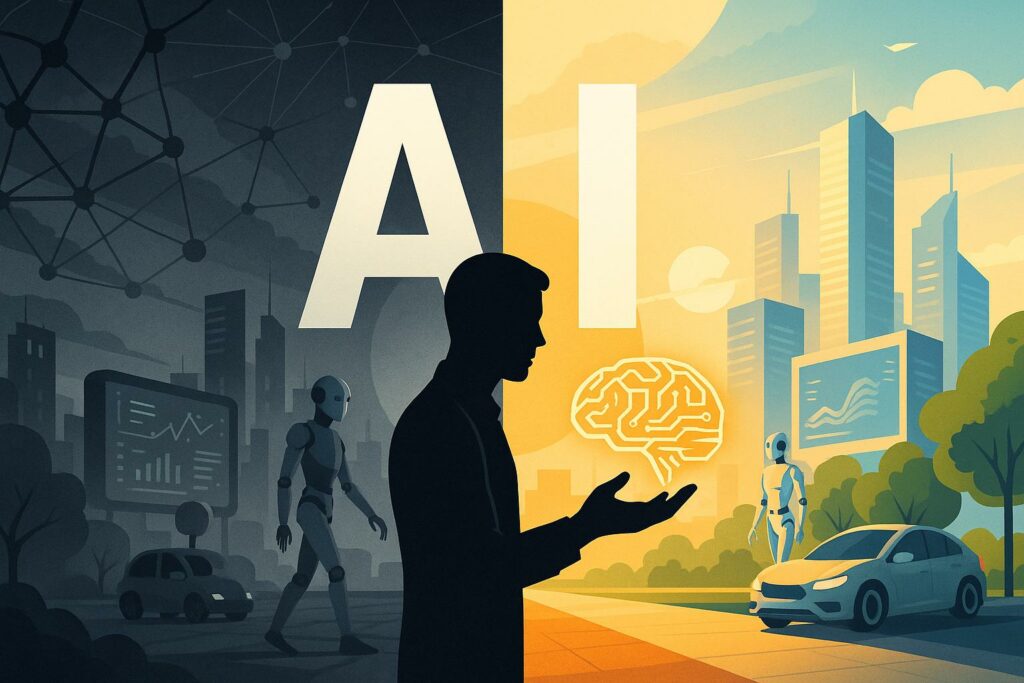
Artificial Intelligence in 2025 is more than a trend—it’s a transformative force shaping how we think, decide, and live. This article explores AI’s real-world advantages, its current limitations, and the profound human and ethical risks it poses.
1. What Artificial Intelligence in 2025 Is Really Changing
Artificial Intelligence in 2025 has become embedded in our daily lives. From voice assistants to automated content creation, from medical diagnostics to education, AI tools are now accessible not just to engineers or researchers, but to everyday people.
Personally, I used tools like ChatGPT and Gemini to build five complete websites in just two months—without any prior technical training. What once required a team of experts and significant funds was now within reach, thanks to conversational AI.
In the health domain, Artificial Intelligence in 2025 allowed me to understand a complex blood test and prepare informed questions for my doctor. It empowered me, not by replacing human expertise, but by augmenting it.
From comparing insurances to planning trips or learning recipes, AI is already a companion for decision-making and learning.
2. How Artificial Intelligence in 2025 Benefits Society
2.1 Adaptive Education for All
AI can personalise learning experiences at an unprecedented level. Platforms like Khanmigo and Squirrel AI offer tutoring that adjusts to each learner’s rhythm and understanding. When I encountered difficulties building a database, AI guided me through every step, tirelessly repeating explanations without frustration.
2.2 Medical Innovation and Diagnosis Support
Artificial Intelligence in 2025 is enhancing diagnostic accuracy and treatment personalisation. According to Nature Medicine (2022), some AI models now match or surpass radiologists in identifying certain diseases. They serve as powerful assistants, not replacements.
2.3 Robotics and Automation in Service Sectors
AI integrated with robotics is addressing staff shortages in elder care, transport, and logistics. Autonomous taxis are being tested in California and China. Future applications include robotic caregivers and hospital assistants.
2.4 Smarter Administration
For freelancers, local governments, or small businesses, AI simplifies accounting, scheduling, and reporting tasks. This administrative efficiency creates space for more meaningful human work—if we manage the transition ethically.
3. The Limits of Artificial Intelligence in 2025
3.1 AI Still Lacks Real Understanding
Despite its capabilities, AI doesn’t “understand” in a human sense. It relies on large datasets and statistical correlations. Ask it something outside of its data, and it often fails. For instance, asking about a culinary technique not documented online can return an empty answer.
3.2 Mixed Performance Across Domains
Image generation, coding adjustments, or logical reasoning sometimes require multiple retries. While fast, AI results are not always precise or reliable. It lacks creative nuance and situational intuition.
3.3 No Awareness, No Morality
Artificial Intelligence in 2025 still lacks consciousness. It doesn’t feel or choose. A Belgian editorial in La Libre rightly stated: “AI only automates the calculating part of human intelligence. It cannot determine meaning or moral value.”
4. The Human-Centred Risks of Artificial Intelligence in 2025
4.1 Surrendering Human Agency
The danger lies not in AI itself, but in how humans rely on it. Delegating ethical or life-altering decisions—such as military actions—to AI systems risks dehumanising responsibility. Unlike a human, AI won’t hesitate or question orders.
Historical example: Soviet officer Stanislav Petrov once refused to trigger a nuclear response during a false alarm. An AI would have launched the missiles.
4.2 Centralised Power and Control
In 2025, a handful of corporations control most advanced AI models. If AI is used for manipulation, surveillance, or profit maximisation without oversight, we risk turning society into a controlled, predictable machine.
4.3 Personalised Manipulation at Scale
Sam Altman, founder of ChatGPT, warns not only of deepfakes but of a subtler danger: one-on-one interactive persuasion. Advanced AI can now engage individuals in tailored, adaptive dialogues—based on personal data, browsing history, and behaviour. This isn’t mere targeted marketing—it’s continuous influence that subtly shapes beliefs and decisions. The threat is not brute force, but personalised manipulation on a massive scale.
4.4 Cognitive Decline and Dependence
The more we delegate to AI, the more we risk weakening key cognitive skills: writing, calculating, reflecting. What happens when we no longer remember how to think independently?
4.5 A Radical Transformation of Work
As predicted by Jeremy Rifkin in The End of Work, AI may disrupt not just jobs, but human identity. Work has structured meaning, routine, and dignity for centuries. The question is not: will AI replace jobs? But: what kind of life do we want beyond the job?
5. Why Artificial Intelligence in 2025 Requires Conscious Guidance
AI reflects what we feed it: our knowledge, our bias, our intentions. It can amplify wisdom or ignorance. The key is not in the technology, but in the intention behind its use.
Artificial Intelligence in 2025 should remain a tool—a servant, not a master.
We need ethical education, collective decision-making, and global regulations that ensure AI serves human development, not control.
Conclusion: A Technological Mirror for Humanity
Artificial Intelligence in 2025 is both a reflection and a test of our humanity. It challenges us to become more intentional, more ethical, and more conscious in the way we design, use, and share technology.
AI is not human. It has no emotions, no body, no intuition. It will never understand joy, fear, grief, or beauty the way a person does. But it can help us reveal our own humanity—if we use it wisely.
The real question is not what AI will do to us—but what we choose to do with it.
Updated on 04 August 2025 with the assistance of AI, using the following instruction:
“Please: Analyse my ideas and correct them if outdated or inaccurate based on recent research. Add relevant, evidence-based content from high-quality sources. Reorganise the article logically. Improve tone, clarity, and engagement. I want a well-informed and balanced article on AI, grounded in scientific evidence.”